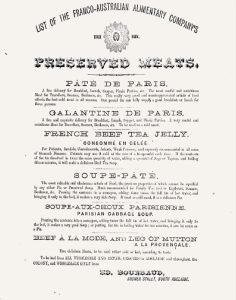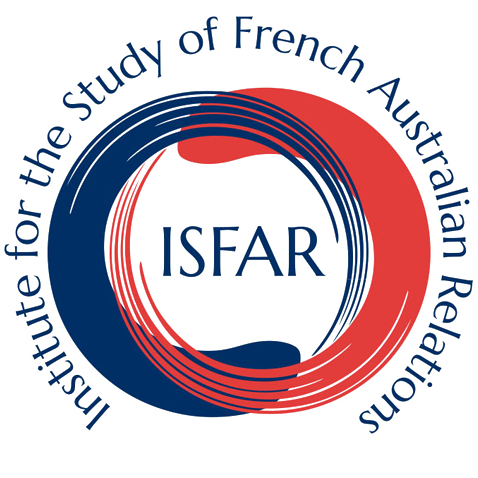 Louis Edouard Bourbaud was the first viticultural expert appointed to any Australian colony. Born in 1837 in Chérac, a small town in the Charentes-Maritime, he was recommended to Francis Dutton, South Australia’s Agent-General in London, as ‘a man of superior intelligence and high respectability … highly skilled in the French wine-making process’; in addition, his wife Mathilde was ‘acquainted with the process of preparing crystallized preserved fruits’ (South Australian Register August 1875). A member of the National Agricultural, Industrial, and Commercial Academy of France, Bourbaud had also served on one of the committees selecting wines to be exhibited at the 1867 Paris Exhibition. The family disembarked in Adelaide in August 1875.
Louis Edouard Bourbaud was the first viticultural expert appointed to any Australian colony. Born in 1837 in Chérac, a small town in the Charentes-Maritime, he was recommended to Francis Dutton, South Australia’s Agent-General in London, as ‘a man of superior intelligence and high respectability … highly skilled in the French wine-making process’; in addition, his wife Mathilde was ‘acquainted with the process of preparing crystallized preserved fruits’ (South Australian Register August 1875). A member of the National Agricultural, Industrial, and Commercial Academy of France, Bourbaud had also served on one of the committees selecting wines to be exhibited at the 1867 Paris Exhibition. The family disembarked in Adelaide in August 1875.
The assistance of the colonial government, however, extended only so far as free passage; no salaried position was offered. Having tasted South Australian wines in London, Bourbaud had some idea of their qualities and potential but on arrival he immediately made a thorough survey of the state of the industry, submitting his report to the Vignerons’ Club two weeks later. In his opinion, many aspects required attention, from vineyard management and harvesting to wine making and storage (Adelaide Observer 1875). Despite South Australian wines receiving awards at the 1867 Paris Exhibition and the 1873 Metropolitan Intercolonial Exhibition in Sydney, after a decade of rapid vineyard expansion colonists keenly recognised their lack of expertise in grape growing and winemaking, the ‘want of reliable information’ representing a ‘formidable barrier’ (Heyne 1868, Preface). Bourbaud presented the assembly with an offer to provide appropriate advice to improve their wines without diminishing yield or incurring additional expenses, for which he asked a contract of 4-5 years and a weekly salary of £10 plus travel expenses. After confirming his credentials—Bourbaud had served on one of the wine selection committees for the 1867 Paris Exhibition and had experience in Burgundy—the vignerons wasted no time in negotiating an agreement, employing Bourbaud at an annual salary of £300 plus expenses (Adelaide Observer 1875).
Rapidly accepted into the circle of industry leaders such as Thomas Hardy and Samuel Davenport, Bourbaud was appointed a wine judge in early 1876 and unanimously voted an honorary member of the Vignerons’ Club. In August 1876 he was appointed manager of the newly-formed South Australian United Vineyard Association, a business created by eight of the most influential winegrowers to encourage wine consumption among the general population by offering sound wines at a reasonable price, together with low-priced ‘working man’s’ wines (South Australian Register 1876). In Bourbaud’s opinion, wine was a wholesome, beneficent beverage and ‘the best guarantee against drunkenness’ (South Australian Register December 1875).
Through Bourbaud, South Australian vignerons had access to the most recent French viticultural and vinicultural science and practice. His learned and technical articles under the title ‘Viticulture and Viniculture’ were published in the Adelaide Observer and South Australian Register between July and November 1876, covering such matters as soil types, siting of vineyards, selection of grape varieties, planting, vine diseases, vineyard management and pruning. They were subsequently circulated in other colonies. Pruning, he observed, was effectively an unknown skill in South Australia and he encouraged improved practices—which, incidentally, would reduce the risk of mildew—together with pruning competitions (Adelaide Observer November 1876; South Australian Chronicle and Weekly Mail 1876).
A prolific correspondent to the Adelaide press, Bourbaud presented scientific reports on such topics as the prevention and treatment of powdery mildew and the use of a densimeter or gluco-oenometer to determine the best time for harvest. He advocated diversification through the manufacture of vermouth, brandy, verjuice, wine vinegar, ‘vin cuit’ (reduced and concentrated must), liqueurs and spirits and medicinal wines, publishing recipes for quinine tonic wine, pepsin wine and sarsaparilla (Adelaide Observer March 1876). As a demonstration of the versatility of the vine, in 1881 he presented the newly opened Museum of Economic Botany with a range of products from wine and raisins to grape syrup, grape sugar, grape jam, grapeseed oil, cream of tartar and potash, and grape charcoal (South Australian Register 1876).
Bourbaud was a fervent supporter of his adoptive home and especially its wines, which he believed had their own individual character and deserved to be more widely known. After recommending South Australian participation in the 1878 Paris Exhibition, he was deeply disappointed that its wines fared so poorly, with no wine deserving more than a third class order of merit, and although Bourbaud’s wines performed best, he resigned from the South Australian United Vineyard Association in October 1878 (South Australian Chronicle and Weekly Mail 1878). He encouraged other nascent industries such as sericulture, sending samples of locally spun silk to manufacturers in Lyon, receiving a very favourable response (South Australian Register April 1879). He also made attempts to foster greater Franco-Australian cooperation, including promoting to French shippers the advantages of direct entry of South Australian goods through the port of Le Havre, instead of via England (Adelaide Observer 1878). Representing the interests of French nationals in South Australia, he requested improved postal relations and better facilities for the interchange of money orders (Evening Journal 1881).
A firm believer in progress through the dissemination of knowledge, Bourbaud recommended the publication of a monthly review that reported details of relevant agricultural research and development from the northern hemisphere (South Australian Register 1879). He revived the concept of a Model Farm, combining it with an Agricultural College that would conduct experiments as well as provide farmers with practical education, an idea realised with the establishment in 1883 of Roseworthy Model Farm and Agricultural College, the first such institution in Australia (Adelaide Observer 1878).
Yet scientific acumen momentarily deserted Bourbaud in October 1879 when, probably through over-zealousness, he mistakenly identified phylloxera in an Adelaide vineyard. South Australian vignerons had been fearful of the spread of the devastating disease after its detection in Victoria in 1877. Bourbaud was clearly familiar with phylloxera which had hit France in the early 1860s, and with the insect responsible, having previously presented a paper on the subject to the Chamber of Manufactures (The Express and Telegraph December 1878). Although he recanted several days later, he felt his reputation damaged and resigned his honorary membership of the Vignerons’ Club.
Almost immediately, however, the indefatigable Bourbaud launched into a new business, the Franco-Australian Alimentary Company, making preserved canned meat products (refrigeration was still in its infancy). The canning industry had begun in France in the early nineteenth century in the wake of Appert’s successful experimentation and initially focused on fruit, vegetables and sardines, but meat products gradually became more significant. In April 1880 Bourbaud presented to the Chamber of Manufactures samples of three of his products – pâté de Paris, galantine de Paris and boeuf à la mode – all of which were very favourably received (The Express and Telegraph 1880). More products were added and promoted at both the 1880 Melbourne Exhibition and 1881 Adelaide Exhibition, where visitors were offered tastings. Soon after the close of the Adelaide Exhibition, however, Bourbaud sold the goodwill in the business to L. Conrad, while continuing as manager. Conrad maintained the full range of fourteen French-style products for another year, alongside his own more English ones such as corned mutton, ox tongues and tripe.
Ever active, in June 1882 Bourbaud reconstituted the South Australian Winegrowers’ Association and became its manager (The Express and Telegraph 1883). At this time he was still advising individual vignerons such as Samuel Davenport and Sir Thomas Elder, and it might have been in one of their cellars that Bourbaud directed the making of an experimental champagne, arguably the first made in South Australia (Adelaide Observer 1880). His sudden death in January 1883 at the age of 45, probably the result of an aneurysm, was unexpected, although he was reported to have been suffering from an unknown illness for two years.
The motto ‘Work, hope and perseverance’ that Bourbaud proposed for South Australia could indeed be applied to his own approach to life (Adelaide Observer February 1876). Obituaries lauded him as a man of genial manners and a cultivated mind, ‘probably the cleverest expert in blending and treating wines that the colony has possessed’ and a man who ‘contributed largely and practically to our local viticultural literature’ (South Australian Register 1883).
His widow Mathilde later married Emile Ulm, an artist who became Bolivian consul in Melbourne, and spent the greater part of her remaining 33 years in the city, playing a significant role in its French community.
Image: Preserved meats manufactured by the Franco-Australian Alimentary Company, supplied by Barbara Santich.
Author: Barbara Santich, Emeritus Professor, University of Adelaide, January 2023
References
Adelaide Observer, 1875, 4 September, p. 9; 1876, 11 March, p. 5; 1876, 25 November, p. 9; 1876, 26 February, p. 9; 1878, 6 April, p. 9; 1878, 8 June, p. 9; 1879, 2 August, p. 9; 1880, 5 June, p. 7.
Evening Journal, 1881, 22 February, p. 2.
Express and Telegraph, 1878, 26 October, p. 2; 1878, 7 December, p. 2; 1880, 27 April, p. 2; 1883, 8 January, p. 2.
Heyne, E. B. 1868. The Vine and Wine Making in Southern France, Melbourne, Walker, May & Co, preface. Translation of André Pellicot, Le Vigneron Provençal: Cépages provençaux et autres, culture et vinification, Montpellier, Imprimerie Gras, 1866.
South Australian Advertiser, 1876, 24 February, p. 5.
South Australian Chronicle and Weekly Mail, 1875, 16 October, p. 9; 1876, 19 August, p. 17; 1878, 14 September, p. 9.
South Australian Register, 1875, 23 August, p. 6; 1875, 28 December, p. 7; 1876, 20 September, p. 4; 1879, 30 April, p. 6; 1879, 24 May, p. 1; 1881, 25 August, p. 3; 1883, 8 January, p. 4.
Keywords: wine, viticulture, sericulture, phylloxera, Australian sparkling wine
